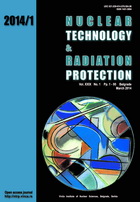
IMMOBILIZATION OF 60Co AND 90Sr IONS USING RED MUD FROM ALUMINUM INDUSTRY
Pages: 79-87
Authors: Aleksandra S. Milenković, Ivana D. Smičiklas, Jelena P. Marković,
and Nikola S. Vukelić
Abstract
The removal of 60Co and 90Sr from the aqueous phase was tested using red mud – the fine grained residue from bauxite ore processing. This industrial waste represents a mixture of numerous minerals, mainly oxides and hydroxides of Fe, Al, Si, and Ti. Experiments were conducted as a function of contact time, pH, and pollutant concentrations. Kinetic data were well fitted with a pseudo-second order equation. The calculated rate constants and initial sorption rates indicated faster sorption of Sr2+ ions. Removal of both cations rapidly increased with the initial pH increase from 2.5 to 3.5. With the further increase of pH, Co2+ sorption was nearly constant (98%-100%), whereas Sr2+ removal remained at the same level to initial pH~8 and gradually increased to 100% at pH 12. Equilibrium sorption data followed the Langmuir model, with the maximum sorption capacities of 0.52 mmol/g for Co2+ and 0.31 mmol/g for Sr2+. Sorbed cations exhibited high stability in distilled water. Desorption of Co2+ was also negligible in the presence of the competing Ca2+ cation, while 42%-25% of Sr2+ ions were desorbed depending on the previously sorbed amount. The results indicate that red mud is of potential significance as Co2+ and Sr2+ immobilization agent due to its high efficiency, abundance, and low-cost.
Key words: 90Sr, 60Co, immobilization, red mud
FULL PAPER IN PDF FORMAT (1,33 MB)
